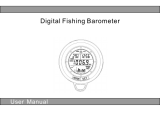
Table of Contents
Introduction.....................................................................1
Device Overview......................................................................... 1
Installing AA Batteries.................................................................1
Battery Information.................................................................1
Turning On the Device................................................................ 1
Using the Touchscreen.......................................................... 1
Home Screen......................................................................... 1
Using the Power Key Menu........................................... 1
Tracks.............................................................................. 1
Recording a Track Log............................................................... 1
Customizing Your Track Log...................................................... 1
Navigating Using TracBack®...................................................... 2
Saving the Current Track............................................................ 2
Viewing Track Information.......................................................... 2
Viewing the Elevation Plot of a Track......................................... 2
Saving a Location on a Track..................................................... 2
Changing the Track Color........................................................... 2
Archiving Tracks Automatically................................................... 2
Clearing the Current Track......................................................... 2
Deleting a Track..........................................................................2
Waypoints....................................................................... 2
Creating a Waypoint................................................................... 2
Finding a Waypoint..................................................................... 2
Editing a Waypoint...................................................................... 2
Deleting a Waypoint....................................................................3
Increasing the Accuracy of a Waypoint Location........................ 3
Projecting a Waypoint................................................................. 3
Routes............................................................................. 3
Creating a Route.........................................................................3
Editing the Name of a Route...................................................... 3
Editing a Route........................................................................... 3
Viewing a Route on the Map...................................................... 3
Deleting a Route......................................................................... 3
Viewing the Active Route............................................................ 3
Reversing a Route...................................................................... 3
Garmin® Adventures..................................................... 3
Sending Files to BaseCamp....................................................... 3
Creating an Adventure................................................................ 3
Starting an Adventure................................................................. 4
Where To? Menu.............................................................4
Optional Maps.............................................................................4
Finding a Location Near Another Location................................. 4
Finding an Address..................................................................... 4
Navigation....................................................................... 4
Navigating to a Destination......................................................... 4
Stopping Navigation............................................................... 4
Acquiring Satellite Signals.......................................................... 4
Navigating with the Map............................................................. 4
Navigating a Driving Route.................................................... 4
Navigating with the Compass..................................................... 4
Calibrating the Compass........................................................4
Course Pointer....................................................................... 5
Marking and Starting Navigation to a Man Overboard
Location...................................................................................... 5
Navigating with Sight 'N Go........................................................ 5
Elevation Plot.............................................................................. 5
Navigating to a Point on the Plot........................................... 5
Changing the Plot Type......................................................... 5
Resetting the Elevation Plot................................................... 5
Calibrating the Barometric Altimeter...................................... 5
Geocaches...................................................................... 5
Downloading Geocaches
............................................................ 5
Filtering the Geocache List......................................................... 5
Creating and Saving a Geocache Filter................................. 5
Editing a Custom Geocache Filter......................................... 5
Navigating to a Geocache.......................................................... 5
chirp™........................................................................................ 6
Enabling chirp Searching....................................................... 6
Finding a Geocache with a chirp............................................6
Logging the Attempt....................................................................6
Applications.................................................................... 6
Sending and Receiving Data Wirelessly..................................... 6
Setting a Proximity Alarm........................................................... 6
Calculating the Size of an Area.................................................. 6
Viewing the Calendar and Almanacs.......................................... 6
Setting an Alarm......................................................................... 6
Starting the Countdown Timer.................................................... 6
Opening the Stopwatch.............................................................. 6
Satellite Page..............................................................................6
Changing the Satellite View................................................... 6
Turning Off GPS.................................................................... 6
Simulating a Location.............................................................6
Controlling a VIRB® Action Camera........................................... 7
Phone Notifications..................................................................... 7
Pairing a Smartphone with Your Device................................ 7
Hiding Notifications................................................................ 7
Fitness............................................................................. 7
Running or Cycling with Your Device......................................... 7
History.........................................................................................7
Viewing an Activity................................................................. 7
Deleting an Activity................................................................ 7
Using Garmin Connect...........................................................7
Optional Fitness Accessories.................................................7
About Heart Rate Zones............................................................. 8
Fitness Goals......................................................................... 8
Setting Your Heart Rate Zones.............................................. 8
Customizing the Device................................................. 8
Adjusting the Backlight Brightness............................................. 8
Locking the Touchscreen............................................................8
Unlocking the Touchscreen................................................... 8
Setting the Touchscreen Sensitivity........................................... 8
Display Settings.......................................................................... 8
Configuring the Maps..................................................................8
General Map Settings............................................................ 8
Advanced Map Settings......................................................... 8
Custom Data Fields and Dashboards......................................... 8
Enabling the Map Data Fields................................................ 8
Customizing the Data Fields.................................................. 8
Customizing Dashboards....................................................... 9
Profiles........................................................................................ 9
Selecting a Profile.................................................................. 9
Creating a Custom Profile...................................................... 9
Editing a Profile Name........................................................... 9
Deleting a Profile....................................................................9
System Settings.......................................................................... 9
GPS and GLONASS.............................................................. 9
Display Settings.......................................................................... 9
Appearance Settings.................................................................. 9
Setting the Device Tones............................................................9
Tracks Settings........................................................................... 9
Routing Settings......................................................................... 9
Heading Settings........................................................................ 9
Altimeter Settings......................................................................10
Position Format Settings...........................................................10
Changing the Units of Measure................................................ 10
Time Settings............................................................................ 10
Table of Contents i























